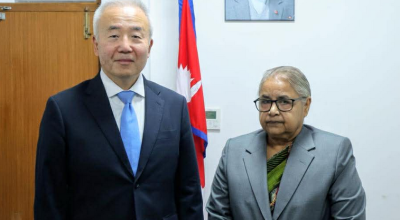
Abstract
Public health concern is increasing with a recent rise in the number of COVID-19 cases in Nepal. To curb this pandemic, Nepal is facing some forms of lockdown, encouraging people to implement social distancing so as to reduce interactions between people which could eventually reduce the possibilities of new infection; however, it has affected the overall physical, mental, social and spiritual health of the people. The objective of this study is to analyze the impact of COVID-19 in Nepal including South Asian countries. Secondary data from Ministry of Health and Population (MoHP), Central Bureau of Statistics (CBS), magazines, and different websites have been used for this study. The nature of this study is qualitative as well as quantitative. This is true that just calculating the impact on tourist trips, hotels, declines in retail trade, decline in remittance, close-down of education centers are not enough to get the real picture of impact on economy in Nepal. There are some linkages in economy across various sectors; both direct and indirect impact need to be calculated as economic shock of one nation will be directly linked to other nations in this global world. The impact illustrated through the qualitative data is far greater than the cost to a health budget of treatment of the cases involved. The more persistent shock is Corona lasting for longer than anyone hopes in this increased globalization. There is need of global monitoring and coordination mechanisms in containing both economic and microbial epidemics as the impact is higher than expected.
Introduction
The segment on the socio-economic impact of COVID-19 is still under development as the full extent of the impact is yet to be known. It is expected that those hardest and most immediately affected by the crisis and the necessary measures of lock-down will be the most vulnerable. The Nepal Preparedness and Response Plan (NPRP) is a living document and will be updated as the situation evolves and as the needs of vulnerable populations are identified. The definition of vulnerable populations is based on that laid out in Agenda 2030 and includes – but is not limited to – women, children, youth, persons with disabilities (of whom more than 80% live in poverty), people living with HIV/AIDS, elderly persons, indigenous peoples, refugees, internally displaced people and migrants.
Corona Virus: At a Glance
Corona-viruses are a group of RNA viruses that cause diseases in mammals and birds. In humans and birds, they cause respiratory tract infections that can range from mild to lethal. Mild illnesses in humans include some cases of the common cold (which is also caused by other viruses, predominantly rhinoviruses), while more lethal varieties can cause SARS, MERS, and COVID-19. In cows and pig, they cause diarrhea, while in mice they cause hepatitis and encephalomyelitis. There are as yet no vaccines or antiviral drugs to prevent or treat human coronavirus infections (Decaro, 2011).
Novel corona-virus named Severe Acute Respiratory Syndrome corona virus 2 (SARSCoV-2) was first identified in a seafood market
in Wuhan City, Hubei Province in China, at the end of 2019 (Zhu et al., 2020). The contagious respiratory illness caused by this Novel coronavirus is called corona-virus disease 2019 or, in short, COVID-19 (Wu et al., 2020). Corona Virus is any of a family (Coronaviridae) of large single stranded RNA viruses that have a lipid envelope studded with club-shaped spike proteins, infect birds and many mammals including humans, and include the causative agents of MERS, SARS, and Covid-19 (Stein, 2020).
On 30 January 2020, the World Health Organization declared a Novel Coronavirus ‘COVID-19’ a matter of public health emergency of international concern. In February of 2020, with the fi rst death from COVID-19 in France and a steep increase of positive cases in Europe (Klonowska, 2020). COVID-19 is spreading fast across the globe.
The COVID-19 pandemic will have multifaceted and widespread impact on the Nepalese economy. The country is still in lockdown phase. The extent of possible spread of COVID-19 and the need for its containment and treatment are uncertain.
Thus, relaxation of restrictions to allow economic activities to start operation is also uncertain. Saving life and containing the spread of the virus is the fi rst priority. At the same time, there is an unprecedented and urgent need for interventions and actions to save economy in this diffi cult period than any time before. To the extent possible, such interventions and actions should be based on plausible evidences and assumptions, which should be updated as events unfold.
Novel Corona-virus (COVID-19 or 2019-nCoV) is an emerging global health concern that requires a rapid diagnostic test (Lamb et al., 2010). According to World Health Organization (2020): “Corona-viruses (CoV) are a large family of viruses that cause illness ranging from the common cold to more severe diseases such as Middle East Respiratory Syndrome (MERSCoV) and Severe Acute Respiratory Syndrome (SARSCoV).”WHO (2020) further states that Corona viruses are zoonotic, meaning they are transmitted between animals and people.
Detailed investigations found that SARS-CoV was transmitted from civet cats to humans and MERS-CoV from dromedary camels to humans. Several known corona-viruses are circulating in animals that have not yet infected humans.
Objectives of the Study
The general objective of this study is to explore and understand the overall impact of Novel Corona-virus pandemic on Nepalese Economy in 2020. The specific objectives of this study are as follows:
- To identify the impact of COVID-19 pandemic in Nepalese economy,
- To give an overview of COVID-19 pandemic in economic parameters in Nepal,
- To analyze the impact of COVID-19 pandemic in Nepal and global level.
- Materials and Methods
Secondary data have been taken from Ministry of Health and Population (MoHP), Central Bureau of Statistics (CBS), magazines, published articles, economic and disaster offices and different websites for this study. The nature of this study is qualitative as well as quantitative.
Descriptive and analytical methods have been used to analyze the data. The transmission approach looks like this:
COVID-19 – Remittance inflow- Economic Growth Rate
Novel Corona-virus Pandemic and Nepalese Economy
GDP in FY 2020-21 The real GDP would have a growth rate of 6.2 percent in FY 2019-20 if COVID-19 pandemic had not affected Nepalese economy and economies worldwide. Economists have projected that economic growth rate of India will be about (-) 7 percent. GDP has decreased by 1.61 percent if one-degree temperature will increase. GDP has decreased 4 trillion Nepalese rupees from 39 trillion Nepalese rupees (https://www.adb.org).
The World Bank has projected Nepal’s economic growth for 2020-2021 at 0.6 percent if COVID-19 disruptions persist and relief expending weakness growth could be as little as 0.1 percent. Global growth is projected to rise from an estimated 2.9 percent in 2019 to 3.3 percent in 2020 and 3.4 percent for 2021—a downward revision of 0.1 percentage point for 2019 and 2020 and 0.2 for 2021 compared to those in the October World Economic Outlook (WEO) (https://www.imf.org).


Economic growth rate of the world has decreased 4.4 percent, 5.8 percent of developed countries, and 4.3 percent of the USA, 8.3 percent of the European Union sector, 3.3 percent of emerging countries and 10.3 percent of India. The International Monetary Fund (IMF) has projected that economic growth of People’s Republic of China is only 1.9 percent.
Employment and Job Loss
It is estimated that about 9.2 lakh people might lose their jobs in the domestic economy during the remaining of FY 2019-20. The domestic job losses come mainly from the non-agriculture sector of the economy. From 5.1 lakh to 6.4 lakh Nepalese people working abroad might return home during FY 2020-21. This means that the economy will have from 11.7 lakh to 15.6 lakh people looking for employment. It is assumed that these job losses will add pressure to agriculture and rural employment.
It is widely expected that COVID-19 will prevail for a prolonged period and unemployment will further increase.
Poverty
An additional 1.65 percent of population (about five lakh people) is estimated to fall below the poverty line due to the short-term economic impact of COVID-19 in FY 2019/20, thus, falling under the transient (short-term) poverty category. At the same time, poverty intensity is estimated to increase from 3.40 to 3.74 percent. These estimates assume contractions of farm income by 0.5 percent, non-farm income by 4.5 percent and remittances by 15.5 percent and use sector-wise income weights by consumption quintile. Nepal is in the fi rst point among 17 countries in Asia.
 Poverty has increased by 12 percent in Nepal (Transparency International, 2021, February). Impact on Trade and Tourism India and China are the major trade countries for Nepal. As the precautionary measures to avoid COVID-19 spread in Nepal, the Government of Nepal closed Rasuwagadhi border on 28 January, completely halting Nepal–China trade (My Republica, 2020a). This closure limited the availability of raw materials which used to come from China for manufacturing goods. On 22 March, 2020, Nepal closed its open borders with India resulting in serious effects in the import and export of goods. Import has lost 12.5 percent due to Corona-virus (The Economic Times, 2020). This resulted in a situation of panic-buying and hoarding of goods among the Nepalese, creating a shortage of goods and supplies. Thousands of Nepalese, who wanted to return to Nepal, got stuck at Indian border points (Al Jazeera, 2020). The travel restriction to and from different international destinations was put in place as a measure to prevent the spread of COVID-19 infection, which massively affected the tourism sector. A large number of Nepalese labour migrants and students could not return to their destinations abroad from Nepal, resulting in serious havoc. Tourism sector has decreased from 3.6 percent to 1.5 percent (CBS, 2020). Tourism sector, lack of hotels, restaurants, aeroplanes, the number of tourists, has decreased due to Corona pandemic.
Poverty has increased by 12 percent in Nepal (Transparency International, 2021, February). Impact on Trade and Tourism India and China are the major trade countries for Nepal. As the precautionary measures to avoid COVID-19 spread in Nepal, the Government of Nepal closed Rasuwagadhi border on 28 January, completely halting Nepal–China trade (My Republica, 2020a). This closure limited the availability of raw materials which used to come from China for manufacturing goods. On 22 March, 2020, Nepal closed its open borders with India resulting in serious effects in the import and export of goods. Import has lost 12.5 percent due to Corona-virus (The Economic Times, 2020). This resulted in a situation of panic-buying and hoarding of goods among the Nepalese, creating a shortage of goods and supplies. Thousands of Nepalese, who wanted to return to Nepal, got stuck at Indian border points (Al Jazeera, 2020). The travel restriction to and from different international destinations was put in place as a measure to prevent the spread of COVID-19 infection, which massively affected the tourism sector. A large number of Nepalese labour migrants and students could not return to their destinations abroad from Nepal, resulting in serious havoc. Tourism sector has decreased from 3.6 percent to 1.5 percent (CBS, 2020). Tourism sector, lack of hotels, restaurants, aeroplanes, the number of tourists, has decreased due to Corona pandemic.
Fig. 1: Forecasted Change in Revenue from the Travel and Tourism Industry due to COVID-19Pandemic Worldwide from 2019 to 2020, by Region

Impact on Agriculture
The agricultural crops, livestock and fisheries are not outside the impact of COVID19 pandemic. Being an agricultural country, the travel restriction and lockdown have affected every stage of the food supply chain, including food production and distribution in Nepal.
Farmers are compelled to dump milk and vegetables after a signifi cant decrease in supply and closure of processing companies and proper markets (Poudel et al., 2020). About 60 percent of employment depends on agriculture (CBS, 2011). Employment in agriculture in 2017-18 stood at about 103 lakhs.
On an average, about 13.5 lakh people are expected to return to their home from urban areas and from abroad in the short-run. That could add about 13 percent to the existing employment in agriculture. As COVID-19 pandemic has reversed the trend of migration, agriculture must be developed in the short-run in such a way that it will provide employment opportunities and boost agriculture production.
Impact on Education
The action of the Government of Nepal to close all educational institutions, even postponement of all national level examinations and restriction on the gathering of more than 25 people together, led to an out-fl ux of more than 300,000 people from Kathmandu in 3 days (Rising Nepal Daily, 2020). Perception of the rural municipality environment as pure, free from germs and contamination, and unlikely to get Corona-virus might have led to the surge in the out-flux of people. The drastic increase in new infection rates, lesser tests, increased media reporting and death tolls have increased public anxiety. The absence of clear messages and the desire for facts have heightened fear among the public and propelled them to seek information from less reliable portals (Rubin & Wessely, 2020). The current pandemic has imposed multiple restrictions on research as laboratories have been closed, and scientists and researchers have been working from home, limiting recruitment in studies. According to the World Bank (2020b), the COVID-19 pandemic has caused more than 1.6 billion children and youth in 161 countries to be out of school, which is close to 80 percent of the world’s enrolled students.
Impact on Media Sectors
The infodemics, misinformation and inaccurate conception are spreading quicker from fake and unauthorized news portal websites, contributing to myths and rumors in the society. Myths related to alcohol, adding hot peppers, ginger and garlic to food, and exposing oneself to temperatures higher than 25° or to cold weather and snow to kill the Corona-virus are misleading people. Therefore, there is a need to be thoughtful and conscious when communicating through social media and other communication platforms (UNICEF, 2020a).
Impact on Health Sectors
The COVID-19 pandemic has brought serious psychological impact among health workers, students and the general public around the globe. Although Nepal lacks routine national-level data on suicide, the data from media and the police suggest that about 5,000 Nepalese people
commit suicide every year. The pandemic-related restraints, such as spatial distancing, isolation and home quarantine are affecting the economic sustainability and wellbeing, which may induce psychological mediators such as sadness, worry, fear, anger, annoyance, frustration, guilt, helplessness, loneliness and nervousness (Bhuiyan et al., 2020; Mukhtar, 2020). In the first month of the nationwide lockdown, a total of 487 people committed suicide, which is 20 percent more compared with mid-February to mid-March, when the number stood at 410 (My Republica, 2020b). The data compiled by Nepal Police show that from the onset of lockdown, 23 March till 6 June, a total of 1,227 suicide (16.5 a day) cases were fi led. By the time, the government lifted the lockdown on July-21, without utilizing the period to improve health care facilities and increasing the number of hospital beds and ventilators, the number of cases had crossed the 115,358 mark (MoHP, 2020, October-13).
Impact on Vulnerable People
According to the Nepal Living Standards Survey 2010– 2011, 25 percent of the population lived below the poverty line (CBS, 2011). The link between poverty and communicable disease is well-evident (Alsan et al., 2011; Bhutta et al., 2014). The slowing of economic growth means incomes will stagnate or even fall and this will impact the living standards of people, especially those with lower incomes (vulnerable people). COVID-19 is no exception and has triggered increasing unemployment, loan defaults and major economic losses around the globe (Kantamneni, 2020). The economic downturn caused by COVID-19 can increase the economic instability, health inequalities and social disparities in Nepal, which can have a huge impact on the poverty levels. While the lockdown has affected traders, especially people with small shops and those with limited sources of income, the poor, marginalized people and daily wagers are more vulnerable.
COVID-19 Impact on Households
The COVID-19 crisis triggered multidimensional social and economic impacts that stretch beyond the primary health crisis. To assess how this crisis is affecting households, a series of questions related to food security, livelihood, and vulnerability were asked. This household analysis reviews (1) impacts on food security, (2) impacts on livelihoods and income, and (3) examines household profiles of those most affected by the ongoing crisis. Price of vegetables has increased by 23 percent (Kantipur 2020, November).
Impact on Household Food Security
To ascertain the current food security situation of surveyed households, two dimensions were examined: (1) households’ food consumption patterns and changes in food consumption habits, and (2) households’ access to food. Additionally, the survey observed the diet quality of children between 6 and 23 months of age by measuring minimum dietary diversity.
The Food Consumption Score2 (FCS) is a key component for assessing diet quality. The FCS is used to categorize households into three groups: poor, borderline, and acceptable food consumption. Poor food consumption corresponds to less than 1500 kilocalories (kcal) eaten per person per day. At national level, nearly 1 out of 4 households had inadequate food consumption, with 9 percent of households consuming poor diets and another 14 percent borderline diets.
Impact on Livelihoods and Income
One of the most telling questions was on the impact of COVID-19 on livelihoods and income sources. Livelihood and income sources are central to assessing households’ access to food as well as their vulnerability to shocks.
Remittance from Foreign Employment
Amid all doom and gloom, remittance so far has been a silver lining. Remittance inflows to epal increased by a surprising 23 percent in the first month of the current fiscal year, fortunately efuting forecasts that the income of Nepalese migrant workers would crash due to the Corona-virus pandemic affecting the global economy.
The growth in remittance is surprising despite tens of thousands of Nepalese migrant workers re in out of the job in major hiring destinations abroad (The World Bank, 2020-2021). Nepal, 19th top remittance achiever in 2019, is popular for exporting labour because of various reasons like civil war, political persecution or economic hardship. Dhungana (2014) observed that most of the remittance in Nepal is going into consumption, which leads to the dearth of resources for investment. The pandemic badly affects the international labour market for Nepalese workers. Thus, it is clear that COVID19 is going to deteriorate the remittance infl ow and is doing other harms to the Nepalese economy (Chaudhary, 2020).
Current and Potential Impact on Remittance Sector
12.5 percent increase has been observed in the remittance sector and 2 trillion, 58 billion rupees has been received as remittance in Nepal (NRB, 2020). Remittance income will be severely affected due to COVID-19 pandemic. The income has fallen by 0.5 percent per annum in
mid-February 2020 after rising by 16 percent for the same period in the earlier year (NRB, 2020). Remittance income of about NPR 879.30 billion per fi scal year, which is 25 percent of GDP, is one of the major sources of foreign earnings.

A sharp decline of remittance will undermine Nepal’s external stability. During the first seven months of current fi scal year (FY 2019/20). Nepal has received remittance of NPR 513.20 Billion of which 50 percent was from 5 Gulf Countries – Qatar, The United Arab Emirates, Saudi Arabia, Kuwait and Bahrain (NRB, 2020).
The remittance income has decreased from 30 to 40 percent in Nepal during this period. It will affect employment and total domestic production (CBS, 2020).

Foreign Direct Investment (FDI)
Foreign direct investment from developed countries has decreased by 27 percent due to Corona-virus pandemic at the global level (NRB, 2020).
Conclusion
While many countries are supporting their citizens with sophisticated health safety-nets and various relief funds, some developing countries have unique challenges with vulnerable population and limited resources to respond to the pandemic. This study presents the consequences of pandemic and lockdown on socio-economic, mental health and other aspects in Nepalese society. The lockdown curfews, self-isolation, social distancing and quarantine have affected the overall physical, mental, spiritual and social wellbeing of the Nepalese. With the beginning of lockdown, the government decided to shut down all cinema halls, gyms, health clubs and museums, as well as banned the gathering of people for cultural, social or religious activities, including temples, monasteries, churches and mosques. In the case of death, the pandemic has disrupted the normal mourning rituals of families.
Although these measures are taken for the protection of people from COVID-19, it has created fear, anxiety and uncertainty among the Nepalese, which needs to be addressed immediately. The economic recessions have put significant financial pressure on many families, which might increase unhealthy conflict, family breakdown, abuse, depression and domestic violence. The psychological impacts of the COVID-19 lockdown might be a challenge for an indefinite time, hence, it is necessary to emphasize and address coping strategies, mental health interventions and awareness using the available resources. The Nepalese economy which is based on remittance, is mostly affected now.
The role of remittance in Nepal is immense on the micro as well as macro-level. This study aims to investigate the possible loss in GDP growth rate for FY 2020 due to possible retardation in remittance inflow (% of GDP) under explosion of the COVID-19. The Government of Nepal should stand on investing in alternative sectors, for instance in rural agriculture, animal husbandry, fisheries, construction, and so on.
Swift action is needed to provide income, social protection, and employment to the people. This includes key investment climate reforms to promote physical infrastructures and access to finance for the informal sector to shorten the transition to recovery.
Research Director, RajarshiJanak University, Janakpurdham
(This article is adapted from Nepal Rastra Bank (NRB) Annual Souvenir 2079 BS.
















